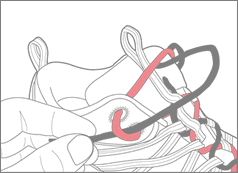
OPTIONS FOR LACING YOUR BOOTS
... keep your boots on, tie your laces properly ...
You would be surprised at how many ways of lacing have been developed. Many are specific to different types of shoe styles but many are also applicable across a wide range of footwear and can be beneficial to prevent common aches and pains. This is just as important in football boots as any other form of specialist footwear. Medical studies have shown that incorrect lacing or generic lacing is the cause of a high proportion of foot correction problems in later life, so it is essential to try and resolve any orthopedic or podiatric issues early in the development of a players feet.
For junior football players it is advisable to apply a lacing technique which will allow maximum comfort and maximum control of the boots as the players move around. As discussed in the two football boot guides, a good boot which is tied loosely is a turns it into a bad boot in use and a badly fitting boot should be avoided completely. Even with good fitting boots it may be helpful to choose a different lacing technique if the player complains about specific pains in their feet, ankles or lower legs. We have provided linked to various practical demonstrations for how to lace and tie football boots and there are plenty more resource on the internet to draw upon.
If in doubt ask you coaches for advice or seek the advice of certified podiatric or orthopedic specialists.
HOW TO STOP LACES UNTYING
The most commona way that we are taught to secure laces is to tie a double knot, i.e. tie a normal bow knot, extending the loops to make sufficient length and then tying another bow knot on top of the first. In most cases this will normally work, however since the laces themselves are not prevented from slipping - or adjusting as feet move in the boots - they can work loose and this will loosen the boots causing them players feet to slip inside their boots.
One trick to prevent laces slipping is to borrow a tip from runners and use a technique called 'lace locking' - as illustrated below and in the videos. Basically, instead of lacin the top two holes normally you lace them parallel - from hole to hole on the same side to create a loop on each side. Each opposing lace end is then threaded through the opposite loop and both laces are pulled tight in a down then outward motion. This creates tension in the laces and the top loops of the laces will hold the loose ends in place with friction.
You can then complete tying your laces as you desire with or without a double knot. This technique works because when the boots are being used, the movement of the feet in the boots will cause more friction on opposing lace loops effectively holding them in place and creating a close fit in the heel of your boots so that the heels of your feet cannot lift away from the sock liner in the boot thus allowing more transfer of power into the ground.


LACING TECHNIQUES AND BENEFITS
Various options for lacing and the how they help are illustrated below for your convenience. Try them out to see which one works best for you. Everybody has different foot shapes and characteristics, so it stands to reason that a single lacing technigue isn't going to fit everyone. In fact some lacing techniques may cause injuries so it is best to find one which works. One thing to consider when using a new lacing technique is that most football boots will come with a generic length of laces - normally they are only sufficient for the type of lacing technique that is shipped with the boots. The expectation is that they cannot cater for everyone and expect anyone who cares enough to get replacement laces anyway. You may need to consider getting laces which are longer, stronger, thinner, round or flat depending upon your personal preferences and needs.




